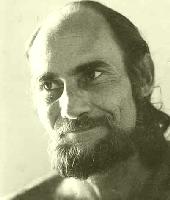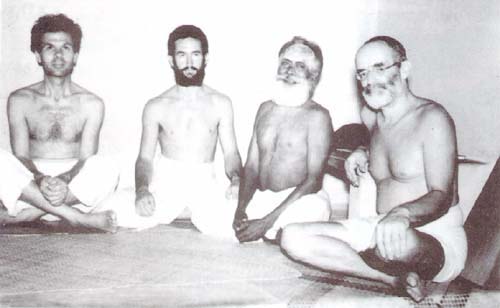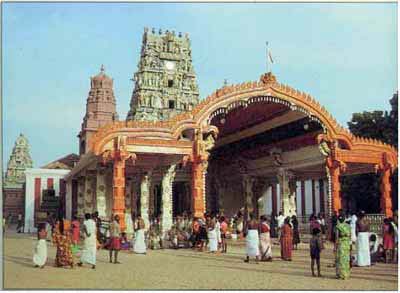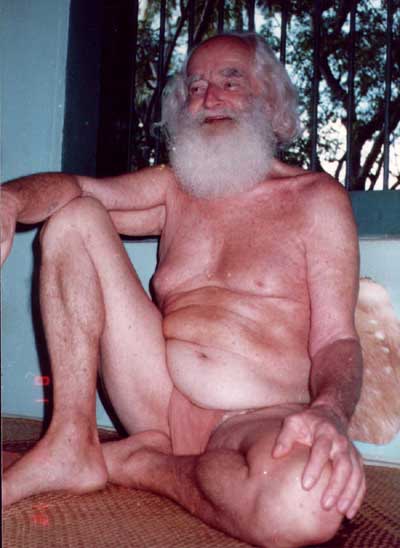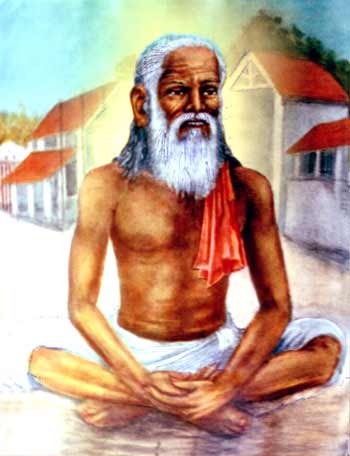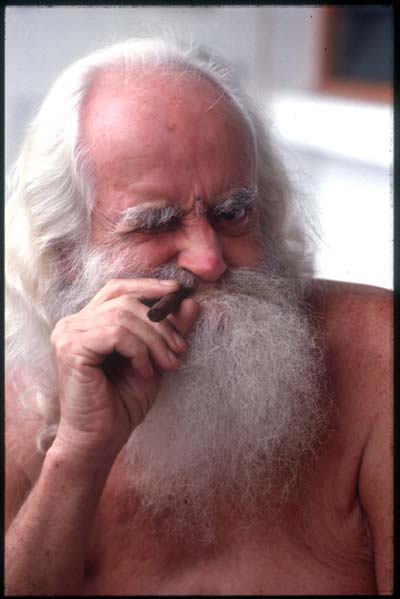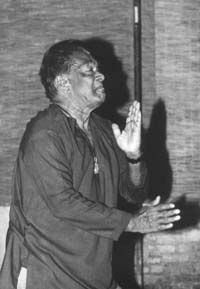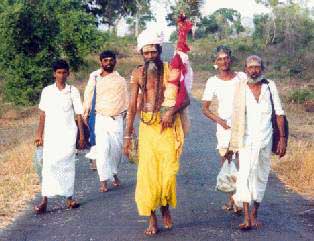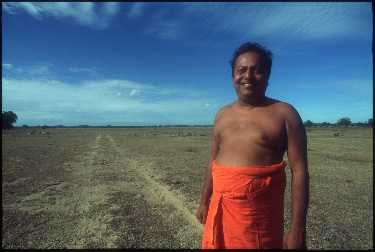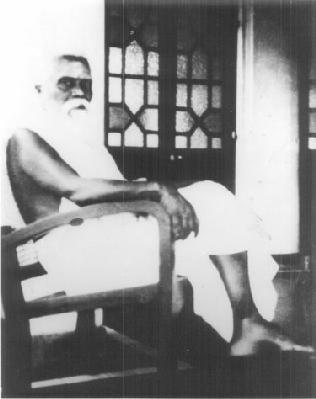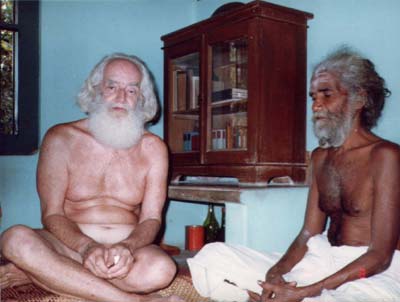|
| ||||||||||||||||||||||||||
|
Murugan's Circus and our Multiple States of Being
By Manik SandrasagraIn 1971 the remarkable German Swami Gauribala introduced me to Saiva Siddhanta Jaffna. I met Swami at the Colombo-7 residence of Mike Wilson, an Englishman who, together with Arthur C. Clarke, made Sri Lanka his home in 1956. Mike and his beautiful Sri Lankan wife Elizabeth ran a safe haven for those who went ‘against the stream' in their home at Barnes Place. For me, a westernized oriental, returning home from a five-year sojourn in an idealistic North America, their home was an oasis of intelligent discussion amidst the gathering gloom and frustration of having our futures chartered by the dowager Bandaranaike. I had first heard of Swami Gauribala in 1963 when I was just eighteen. My informant was Soundhi Sittampalam, my friend Maya's mother. Their home off Flower Road was the temporary halting place for the gifted tenor Nihal Fonseka and me, rehearsing Cole Porter's Kiss Me Kate directed by the American Bert Stimmel, at the Lionel Wendt Theatre nearby. The Sittampalam household was also unique in many ways. There was Soundhi's husband; Sitta sitting for hours with a man called Mahalingam reading peoples horoscopes from ancient ola leaves. Sitta was both Commissioner of Inland Revenue and Colombo's foremost astrologer. We never spoke to him, but could hear him as well as Mahalingam's monotonous chant in the background.
YogaswamiThere was also a bearded Australian house guest in a loincloth, called Nari Kutti Swami. He was described as a disciple of Yogaswami, the sage of Jaffna. The Sittampalam home was essentially a Hindu Tamil home, while I was a Jesuit-taught Roman Catholic. They had a constant flow of visitors, many of whom were Yogaswami devotees. In the ‘Thus have I heard' tradition, I was introduced to this mysterious lineage; a lineage I never knew at the time I would one day be an integral part of. I was told of Yogaswami's other foreign disciples; German Swami or Gauribala and Yanai Kutti or Sanda Swami, the son of Viscount Soulbury, the last British Governor General of Ceylon. I was also told of an old lady, called Haro Hara Amma, who lived on a tea estate below Adam's Peak. All these stories of mystery and magic intrigued me and influenced me in my formative years. Slowly I was returning to my origins from at least four generations of Roman Catholic conditioning. With the production of Kiss Me Kate my apprenticeship under Sri Lanka's foremost theatrical personality Arthur van Langenberg and my showbiz career began. Promoting Nihal Fonseka whom I met on this production here and in the West would be my main pre-occupation for the next seven years. This also led me to Yogaswami, although I did not know it at the time. I met George Koch the photographer in 1964 at ‘Lukannon' in Thimbirigasyaya, the last Van Langenberg family home in Colombo that they shared with the Macks. This was yet another spectacular environment, where Bevis and Geoffrey Bawa, Manjusri, Gamini Fonseka, Harry, Lester James and Harold Peries were all part of "an endless procession of fascinating visitors," as their niece Barbara Sansoni describes it in her book The Architecture of an Island.
JaffnaWhen George discovered my obsession with cinema he invited me to be his assistant. We made three trips in all. One to Adam's Peak, the second to film the vanishing Veddas in Gal Oya and the third to Jaffna where we documented on 16-mm film the Nallur festival. On this last trip our hosts and patrons were Satchit and Linga Satchitananda. We went to Jaffna by train surrounded by a bevy of Hindu Tamil girls, and my obsession with refinement commenced. When we got to Jaffna we went to a house very close to the temple, where we stayed and very soon we set out to the holy precinct to begin our work. However the matriarchal Linga made me shed my western clothes to wear a white vetti while remaining bare-bodied before we were allowed to be escorted to the temple to hear a relation serenade the deity. George the Dutch Burgher was allowed to remain as he was. I was completely transformed into a Shaivite, which is what my name signifies anyway, but dressing up like one was a brand new experience for me, just trying to keep my cloth up. Now looking back, having worn eastern clothes for over twenty-five years, this was the first time of cotton and comfort, although it was Swami Gauribala in 1971 who initiated me on how to wear a vetti properly with no fear of it coming loose. On this expedition to the Nallur festival I followed George everywhere. One of the places we filmed in was the chariot hall, which was full of saffron-robed swamis. At the time the swamis did not hold my interest, as there were too many of them. It was many years later, when I was very much a part of this lineage that I realized that Yogaswami and his ‘kuttis' or cubs always sat here during the procession and that I had unwittingly been granted a darshan with Swami, without even knowing it. EnglandIn 1966 I found myself in England planning to launch the carrier of Nihal Fonseka who had the sponsorship of J.R. Jayewardene, Bunty de Zoyza, Clarence Amerasinghe and Mubarak Thaha who helped him train under a ‘bel canto' specialist called Maestro Guido Delni. At home both Aubrey Walpola and Anandaraja Hallock had taught Nihal all they knew and had recommended an Italian voice teacher rather than having his spectacular talent ruined by local mediocrity. In between our other activities, which included recording Nihal singing ‘The Master Hand' by Nimal Mendis with a 30-piece orchestra, I found myself visiting Mano Chanmugam regularly in Wallington to work on a film script called the ‘White Swami' with Rex Cooke, who shared Mano's home with him. The script was based on the stories I had heard from Soundhi. The Beatle George Harrison, whom I had met through John Barham, a fellow sitar student under Pandit Ravi Shankar, was the first to read the script and call me at Mano's with great enthusiasm. He wanted my permission to share it with Mick Jagger. However the Indian guru of ‘Transcendental Meditation', Maharishi Mahesh Yogi, arrived in London at the same time as I was pushing my script. A star-studded cast turned up at the London Hilton Ballroom to hear the Maharishi and I lost my stars as they took off with the Maharishi to discover transcendental bliss in Bangor Maine in Wales. Nihal and I returned to Ceylon in 1969 on a short holiday en-route to Singapore to perform at the Arundel Room at the Goodwood Park Hotel and I proceeded to search for the legendary Haro Hara Amma. In the meantime the Sittampalam household in Colombo had disintegrated with Soundhi moving to London with Maya and I had to proceed to Adam's Peak with just one clue – a most curious name. Haro Hara AmmaI asked around the tea estates that lined the road to the sacred peak for Haro Hara Amma and to my surprise I found her. She was well known as a Murugan devotee who always went to Kataragama on Pada Yatra. She was now very old and sat huddled in a corner in an estate line, saying little or nothing but staring at me. I left satisfied that for some mysterious reason I had found another link in the chain, but I did not know why. Haro Hara Amma seemed like any other poor estate Tamil woman. Later on I would be told that she was an expert in tattvam -- seeing the inner reality behind appearances. Spontaneously she named all the Yogaswami devotees who hung out with German Swami in Kataragama after wild animals. Besides Nari (fox) and Yanai (elephant), there was a Puli (leopard) – Sam Wickramesinghe, a pandri (pig) the only one of them I never met who was also called ‘Mudaliyar' and who was said to be related to Sir Chittampalam A. Gardiner - and a punai (cat) – Adrian Snodgrass, now a reputed Buddhist scholar. German Swami himself was ‘petta nāy' or the bitch. I was told that he would sing an English drinking song as he walked with this pack of animals, the other ‘kuttis' on the way to the Menik Ganga for a bath! "Drink puppy, drink, let every puppy drink, that is old enough to lap and to swallow. Here's to the fox and here's to the hound, and here's to the chase that we follow."
He was undoubtedly the bitch, the ‘kuttis' puppies and the chase was the search for the Holy Grail. Everyone's guru was Yogaswami, and this was the only thing they agreed upon. Every one of them was distinct and each initiated according to their individual nature. Gauribala was the only one initiated as a sannyasin, confirming his earlier initiation in the North of India into the Giri Order of Dasa Nami sannyasins. Maggi Lidchi has documented this period in Kataragama in her novel Earthman published by Victor Gollancz, the film rights of which Richard Boyle purchased in 1978 so that we could turn it into a movie. In fact I commissioned Tissa Abeysekera to write the screenplay, and he produced an excellent structure for a movie, which we were however unable to finance. German SwamiI finally met Swami Gauribala in 1971. It was a magical moment. He was quite unlike my idea of a swami. He was sitting on an easy chair, bare-bodied, dressed in a pure white cotton vetti, looking rather like Santa Claus and puffing at a smelly black Jaffna cigar. He had the words ‘summa iru' tattooed in Tamil on the inside of his left arm. I had never before met an iconoclast of his quality. He looked at what I was reading and chuckled. "An autobiography of a Yogi! A yogi annihilates selfhood. How then can a yogi who is a nobody write an autobiography?" This was his opening line. He also ridiculed the production I was engaged in called 'New Age' introducing to Ceylon the music of Bob Dylan and a variety of modern American musical crusaders. He chuckled, "New Age - all balderdash! It was completed long ago. All finished". White RabbitSwami also introduced me to Sigiriya in 1971. Our party included Jocelyn Rouleau, a niece of the then Prime Minister of Canada, Pierre Elliot Trudeau and Carol, another Yogaswami devotee and spouse of James George, the former Canadian High Commissioner in Ceylon, India and Iran, with whose assistance the photographer Rollof Benny produced several breathtaking volumes. We were given a rare treat with Swami being our guide in a place that he knew intimately. In fact he called himself King Kassapa. I became the ‘White Rabbit' and Jocelyn ‘Alice' in this voyage of discovery.
Swami also read my script of White Swami with great interest. He confirmed a few events that I had described in my script as fact, and this amazed me. These incidents known only to him, which even the ‘kuttis' had learned from Gauribala, were in the script. My name and its meaning in Saivism (which I did not know), my father's lineage, my meetings with Haro Hara Amma and Yoga Swami; and finally the script made Swami look at me with greater interest. The other so-called coincidence that I was told much later was that Gauribala was performing a series of homa pujas under the patronage of Wilmot Perera at Śrī Palee in Horana in 1954 at the same time that I was schooling there, since my father was the District Medical Officer. All this made our relationship special. For Gauribala, Yogaswami was alive and like the Buddha, was the Dhamma he taught. Reading the notebooks he meticulously kept of his meetings with Yogaswami, it was obvious that he taught me in the same manner. The transmission of this knowledge is through mudra or a silent show of hand speechlessly spoken. This tradition of ‘speechlessly spoken' transmission is presented through a collection of verses in the book Swami compiled in Tamil called Summa Irruka Suttiram, which he presented to me much later on, with the inscription to "Bāla from Bāla". Bāla in Sanskrit is ‘child' or ‘fool'. Siddhas
This compilation which many of us helped translate into English has yet to go into print. It concerns "The Multiple Meanings of an Initiatic Mantra of the Tantric Siddhas of Tamilnadu in the light of the Perennial Philosophy". Included are Yogaswami's own contribution to this literature – the four maha vakyams or Great Sayings given by Chellappa Swami, the great siddha and jñāni of Nallur, to his disciple Yogaswami in the course of four years. Here are two parallel translations.
Sacred utterances in old languages like Tamil and Sinhala have multiple meanings, and history we know is what we make of it in the present. We have also been taught that we are what our thoughts are made of. Originally language was sacred and secret and the preserve of the priestly caste. Right definition was the greatest skill. Individual opinion was unimportant and interpretation always in light of the eternal substance, the Perennial Philosophy, the Akalika or Sanatana Dharma. This brought balance and liberation while the opposite brought strife and conflict. Enlightened self-interest or greed were the options, and the battle was one between light and ignorance. Who is to be revered: the Arya Sangha who are catholic in their attitude or ‘rogues in robes' promoting exclusivity? ‘As it was in the beginning is now and ever shall be' is a constant chant in the Latin mass, and how true that remains! Yogaswami joined the Holy Feet of his Guru on 24th March 1964 and Gauribala became our thread to Yogaswami, the siddha. This Eelam of Saiva Siddhanta culture has Kailasa in the North and Kataragama in the South as its axis. It is not a nation-state but a state of being or awareness. It exists along every single spinal cord. It is also referred to as ‘remembrance' or memory and according to tantric beliefs it is Kundalini – the coiled serpent that lies dormant at the base of our spines. This Eelam is not just one world but also many worlds. Modern aspiring people, however -- Tamil or Sinhala -- know nothing of these worlds. In this world the only war is internal and victory is liberation from delusion. Such a world still exists in Jaffna as in other rural regions at the bottom of the social structure, where bhakti (devotion) and jñānam (wisdom) rule. Cultivators, fisher folk, toddy-tappers, tom-tom beaters, palanquin bearers and all the little people worship Amma or the Earth Mother. They are summa. Their lifestyle is summa. Summa is a state of being, where tranquility and serenity replace paranoia and fear. BhaktiSwami Gauribala gave me entrée to this elite in 1971. Thirty-one years later I went to Jaffna on May Day 2002 to celebrate the eighteenth anniversary of his samadhi and announce the revival of the Pada Yatra from Nagadipa to Kataragama with Kingsley Perera, an ex-JVP activist now working with me. My association with this lineage permitted me after all these years once more to enjoy the hospitality of simple people everywhere that know and share this worldview. At places like Selva Sannidhi, Vallipuram and Mattuvil, the view is the same. Bhakti (devotion) and jñānam (wisdom) still reign.
Gauribala's several notebooks on his meetings with his Guru contain the essence of this tradition. These observations have not been printed and available only to those close to the lineage. This is quite unlike the other publications on Yogaswami in print, including the bowdlerized version authored by the one-time American dancer-turned-guru Subramuniya and his Saiva Siddhanta Church. The Gauribala notebooks are manuals for a sannyasi disciple, not just compilations of sayings and utterances quoted out of context. Gauribala never converted Yogaswami into a saint or an icon. He himself did not collect disciples nor sought popularity by good deeds and public acclaim. He danced until he died, living as Yogaswami had taught him. He was Yogaswami's only disciple who renewed life instead of becoming a sanctimonious and serious bore. Swami had the advantage of not being understood by a middle-class urban mentality and this anonymity made it possible for this ‘nobody' to be anybody at any time. Here was the freest spirit I had ever witnessed, free of even the doctrine. He had crossed the stream and had no need for a canoe any more. SamadhiEven in death he succeeded, since he wanted no trace of a tomb or samadhi. Yogaswami's samadhi -- created by lay-devotees who missed the whole point of his subtle exposition of the Dharma – was once an Army camp and now a sealed tomb visited twice a day for a pooja! Gauribala, who escaped middle-class adulation on Yogaswami's explicit instructions, has no Samadhi at all. Soon after he passed away his ashram was overrun by the military and reduced to rubble. Swami wanted it just that way. A great hunter leaves no trail! I asked Dominic Sansoni to photograph Swami Gauribala. He was getting old and one day the pictures would be invaluable. When Dominic sought his permission to do so he agreed on the condition that Dominic photograph only what Swami wanted revealed. There was also another condition: I was not to be shown the pictures. After Swami passed away on May Day in 1984 under more magical circumstances Dominic told me the story and gave me the pictures that he had taken. The pictures made complete sense mostly to me. Together with his letters in my possession it was proof of the legitimacy of the experience I had in 1971, which I thought was my imagination. The lineage I had been initiated into – is a paramparawa in which our teacher is God Kataragama himself as Siva Dakshinamurti. Only after Swami joined the feet of his own Guru was there confirmation that he was aware of what had taken place between us. I was now a Kataragama convert for life. Deviyange KaeleI did not accept the initial invitation to walk from Jaffna to Kataragama in 1972 although others did including the American Patrick Harrigan who also met Swami for the first time in 1971. Swami himself first walked the Yatra in 1950, having met Yogaswami in 1947. Swami and I were now on the road to becoming firm friends, as he had succeeded in arousing my interest and passion in the Kataragama tradition early in our relationship. He used every opportunity to guide my reading and kept insisting that the mature Ananda Coomaraswamy and the Frenchman Rene Guenon were the only worthwhile authors left while scoffing at "traditionalists" trying to give a new brand name to the Eternal Doctrine, and seeing problems where none existed.
In the meantime, Mike Wilson, who was delightfully crazy in his own inimitable way, decided to swap his householder role and become a swami, calling himself Siva Kalki, and believing that he was the last avatar of Vishnu. He left his home with the Swiss artist Aiyar, who subsequently became the Bhikku Sumedha and together they made their home in a cave on Vallimalai, one of the Seven Hills of Kataragama. This cave became my other place of pilgrimage and reflection and Swami Gauribala, Chitrasena and I would visit our friends who were in the process of being transmogrified into holy men. These visits enabled me to fall in love with the wonderful mystery tradition that was said to hold sway in Deviyange Kaele or the ‘God's own Forest' and meet up with a variety of individuals, including Matara Swami, who remains my fast friend to this day. Pada YatraThis attraction led to me to allow myself to be persuaded with wonderful stories of myth and magic, discard my Gucci shoes, my elegant shades, my life support systems including what money could buy. So I joined German Swami on this crazy pilgrimage to Kataragama in 1975 with a group of his friends he described as the Kopi Kuttam since they stopped intermittently for coffee. Swami's injunction to me was to walk from Pottuvil to Kataragama in not too difficult a sequence for me. Swami's letter that sealed my decision read as follows:
He had never written like this before. He had admitted that he was our guru. He never confirmed such matters, although in a letter to me in September 1971, soon after our first mystical encounter he wrote, "You did really splendid and I am very, very happy indeed. Let us hope that the Great Mother (Para Shakti) will bless you in your efforts to become a firm ring in the chain of our paramparai". I now believed my earnestness in becoming a link in this chain of transmission had been rewarded and I joined the
There were several kuttams. I came to know some of them. From Jaffna itself there was Weerakatti and Muttukumaru while Kandiah and Hanuman were from the East Coast. Chelladurai, Kumaravelu and Aiyadurai were my other comrades in the Kopi Kuttam that German Swami led through the forest, propelled by great stories, lots of Jaffna cigars and a siddha preparation for extra energy called suranam. When walking barefoot gave me blistered feet, the crazy jñāni Aiyadurai Swami took me for a walk and made me stand on fresh elephant dung and by magic my feet were cured. Such were the serendipitous discoveries I made on the journey! Chitrasena was a dancer and fit, while I was not and together a comic sight, like Jeff and Mutt. We walked carrying a pole on our shoulders with our earthly belongings hanging from it. We allowed the Kopi Kuttam to totally dominate us and we did as we were told. We were too tired to think. This walking was killing us. When I had just about given up the fight grace appeared in the form of a chanting group. I joined the group and decided to move with them. Nobody waited for another on the Yatra especially, in the jungle, and one had to keep moving or be left behind. Joining this group and chanting with them induced a trance in which we walked effortlessly for over five miles in record time, with no effort. This was yet another encounter of serendipity. Haro HaraOn reaching the banks of the Menik Ganga the pilgrims piled up several logs and performed a fire-walking puja at night. Everywhere there were shouts of Haro Hara. We were two days away from Kataragama. What impressed me most was the order in which everything was undertaken. The pilgrims were well disciplined. Every kuttam had a leader and he dictated the murai or order to be followed. They treated the forest as belonging to God. They harmed nothing. The animals knew this as well. When an elephant was sighted the pilgrims would approach it and conduct a puja with a coconut and camphor. The elephant stood still. They knew this pilgrimage from inherited knowledge and had no fear. One incident remains in my mind, how we came to a crossroad in the jungle. The pilgrims halted with indecision. While seated we heard a voice singing: "Hallelujah, I'm a bum. Hallelujah I'm a bum again. Hallelujah, give me a handout, to revive me again". It was German Swami announcing his arrival. The pilgrims pounced on him with anticipation, with cries of "Swami, Swami, tell us the way?" And Swami points at one of the paths and quietly sits down on the left, clear off the road to light his black Jaffna cigar. The pilgrims leave shouting Haro Hara and Swami replied while he chewed on his cigar. After a while Swami decides to move and we follow him. He takes the other road. We ask him why? He answers, "I am German and they are Ceylonese. They don't know their own land. They should learn by walking a little more". Lineage
German Swami and his guru Yogaswami, whose guru was Chellappa Swami, whose guru was Kadai Swami, were all tantric siddhas from a Tamilnadu lineage. Their Adi Guru was Siva as Dakshinamurti, who sits in silence on the south face of every Shaivite temple. Dakshinamurti is the southern face of Dharma. Kataragama has several lineages or paramparawas. Matara Swami, the current high priest at the Kiri Viharaya Vishnu Shrine in Kataragama, is a Sinhalese disciple of a Malayali teacher called Sankara Pillai. He was a mantaravadin or magician and this knowledge he taught his disciples who revere his memory to this day. The incumbent of the Vedahitikanda shrine atop the central of the seven hills of Kataragama, Ven. Siddhartha is yet another disciple. In fact his custodianship of the hill shrine is based on his lineage. Lineage and the chain of transmission are the secret of the different guilds, castes or paramparawa – a kind of classification based on temperament. Summa Iru was the core teaching of our group. In Sinhala it is ‘nikang inda'. This was common-speak, and was our nirvana and samsara transcending explanations. All contradictions were resolved in Kataragama, a seat that from time immemorial had attracted rishis and buddhas. In this dispensation there are several paths to the Divine. As many paths as the God has faces -- six in all: Hunter, Warrior, Swami, Beggar, King, Husband and Lover. Nothing is excluded here. Unlike the purity of other shrines, in Kataragama venison is offered twice a week to the god and an Idumban puja includes alcohol and kansa. In recent times however intolerant urban planners have banned everything, including sex, in this age-old fertility shrine. Such is the ignorance of the blind. Foreign Minister Tyronne Fernando, who was a lawyer at the time, met me in Kataragama to rescue me from the Pada Yatra. He took me back to Colombo to finish his film Colomba Sanniya that I was directing for him. I never knew at that time how significant all these events would be later on. AmbushMany years later all that was forecast by Swami in his letter to me had come true. I brought into being the Kataragama Devotees Trust and had gathered around me all Swami's acolytes from ‘the four quarters of the world'. We had made a trilogy on the Skanda story for television that was very well received. We revived the Pada Yatra from Jaffna to Kataragama in 1988. We also re-instated in the annual perahera the ritual ambush by the Veddas, of which I first heard of from Swami. This had gone into abeyance ever since Boranda the Vedda had died some forty years ago. I went in search of Boranda's descendents and found a son who could remember accompanying his father to Kataragama when he was just ten years old. He could remember what was done. I was successful in obtaining the support of the Basnayake Nilame at the time the late Jayewardene Attanayake who agreed to permit Bandiya to carry out his rajakariya duties once more. Our own lifestyle and work still keeps the lineage active. As he had stated in his letter to me in 1975 his ‘mission' in Lanka had been completed and he could depart! In 1984 Swami Gauribala passed away under even more magical circumstances and Rose Collingwood, an American girl whom I had taken to Swami in 1971, had returned to light the pyre and destroy the evidence that there ever was a Gauribala. That year I walked the same route again from Pottuvil to keep memories alive but it was discontinued the next year. Swami had never asked me to walk from Jaffna, suggesting that I do the Pada Yatra in parts and in not too difficult a sequence for me. He always treated me with great affection and respect, although he teased me constantly in order to destroy my self-image. 1988 Pada YatraIn 1988 it was decided by a few of us to set up the Kataragama Devotees Trust and to re-start the Yatra that had not been performed from Jaffna for over four years. The IPKF was in Sri Lanka, the JVP active in the south, the LTTE in the north and east and our armed forces confined to barracks. We approached the Jayewardene Government with our proposal to reinstate this ancient tradition. President Jayewardene endorsed our proposal by ordering the National Security Council to give us all the assistance we needed. Although Indian High Commissioner Dixit and General Kalkat were worried that mischief-makers would attack us, we were adamant that the pilgrimage would take place. We needed nobody's permission to carry out our ancestral rites and customs. The IPKF gave us every assistance and so did the Sri Lanka Army, Navy, Air Force and Police. The World Association of Christian Communications (WACC) was a European NGO doing good with Christian tithes. Neville Jayaweera was one of their flag bearers. He came to Sri Lanka with a colleague called Dr. A. D. Manuel and together with the Marga Institute they decided to set up COMPAR, an acronym for ‘Communications for Peace and Reconciliation'. They wanted to wage peace, and they got together a team of communicators. Mudiyanse Tennekoon and I representing the Kataragama Devotees Trust found ourselves sitting in the Marga boardroom listening to retired bureaucrats trying to be relevant. The road to hell is paved with good intentions. Here was the origin of the urban ‘peace lobby' trying to teach natives about conflict resolution padded with cash. We too needed some cash to launch a media campaign to remove the fear psychosis that had stopped pilgrims from walking from Jaffna to the sylvan shrine in the south. WACC would only finance newspaper advertisements and a media blitzkrieg. This was okay since the Pada Yatra pilgrims moved through faith and needed no inducement to go on pilgrimage to the festival of their beloved Murugan. We needed to only to announce the pilgrimage and the rest would follow. There were no leaders and no fixed agenda like praying, meditating, silence, etc., which urbanites find important. To these pilgrims who had received a call from their God, life itself was amaiti or peace. To them all conflict was irrelevant and the only battle one of svaraj – the inner battle of self-control. NagadipaThe only way to travel is the Government way and no small wonder that people seek political power. Thanks to the JRJ Government we went to Nagadipa/Naintativu in two hours from Colombo. A plane to Jaffna, a chopper to Gurunagar and a speedboat to Nagadipa, The Navy met Dominic Sansoni and me at Nagadipa and politely asked us our requirements. We asked for two bicycles and rode off on them having patiently dismissed warnings of the LTTE being behind every bush. I told these most concerned Navy officers that I had a secret weapon – an anti-terrorist device. Within ten minutes we were stopped by the ‘podiyans', who claimed that we were riding their stolen bicycles. There was only one response that was possible and that was laughter, and this the boys least expected. Very soon I had my secret weapon out and we were being treated with great respect bordering on veneration. My secret weapon was a photo album with three photographs. One was of Murugan the god of Kataragama beloved to all, the other a picture of German Swami whom everyone in Jaffna recognised and the last picture was of me together with the South Indian film star M.G. Ramachandran, who had inspired even LTTE supremo Velupillai Prabhakaran. My anti-terrorist kit was all the permission required for us to spend two memorable days in Nainativu thanks to local hospitality. We then proceeded to Vattappalai or Mullaitivu. This time I had Mudiyanse Tennekoon and Sunil Situnayake with me. Once again the Air Force flew us in and the commanding officer of the camp drove us some distance before dropping us off as it was out of bounds for the military. We walked a few miles and reached Mulliyawelli. Here we witnessed another wonderful sign. We knew nobody and we were standing self-consciously in the crowded temple courtyard when Sunil walked up to me with a stranger who wanted to know who I was. I asked him why, and he responded that he had seen and heard me laugh and that it reminded him of a friend he revered. I asked him who his friend was and he said German Swami Gauribala. I laughed aloud once more and showed him my album, and told him that he had sent me. The man was overjoyed and his home became our home for our two-day sojourn. When we left all the women folk gathered in the compound to wish us farewell, especially to Mudiyanse Tennekoon, the Sinhala Goviya whom these Tamils had learned to love. Kataragama-Skanda TrilogyThis was the beginning. The media campaign continued. When we got to Trincomalee there to greet me was Patrick Harrigan. Patrick had arrived the previous summer to help me write the script for the Kataragama-Skanda Trilogy that I had already documented on video for Frank Jayasinghe and the Worldview International Foundation. We needed the material that I had videotaped under the guidance of the Kataragama Guru Paramparawa, especially Matara Swami, to be understood and presented in a script format that could be narrated by Vijaya Kumaratunga and Swarna Mallawaratchchi in Sinhala and Richard De Zoysa and Michelle Lembruggan in English. When Patrick returned in 1987 he was an UC-Berkeley doctoral student who had been spending time with German Swami between periods of study. Now he got to know me and my merry band. Like the ‘kuttis' around German Swami learning of Yogaswami, the process continued with the next generation sharing the same stories. Only the storytellers had changed. This is how Patrick documented his experiences in the Sunday Observer in September 1987: "So when Sri Lankan film director Manik Sandrasagra extended an invitation to spend the summer holidays in Sri Lanka helping in the completion of a three-part television series about the legends of Kataragama, I gladly took the bait. Little did we know what would arise from this little work of ours. Our 'Work' in the sense that many have been contributing for a long, long time. We were all devotees of God, in one form or another. All just do what comes naturally. Not only Manik, but also others, like Farmer Mudiyanse Tennekoon, have allowed me to accompany them to places like Munneswaram and Kataragama. Through them, I was introduced to many facets of traditional lore, and came to meet other like-minded people, all luminaries in their own light, all models of humanity.
Alter EgoI spent long days and evenings in the company of characters like Selladurai, Kumaravelu, Sam Wickramesinghe and Bhikkhu Nyanakhetto. Often we would just sit cross-legged by the light of a campfire or oil lamp, exchanging stories and jokes, of which not infrequently I was the butt. Just to understand all the stories, puns and remarks, one would have to know at least three languages. And yet, however simple they might be, everybody drank their fill at these beggar's banquets – wit and common sense, not sophistication, are what distinguishes this community of seers and jokers. They are called Hindus, Buddhists, Muslims, Christians or frauds by others, but they all speak a common language and discuss the same issues. As diverse and motley as their appearance might be, they all share in a common deep-seated faith in the ultimate harmony of all things. For them, there is justice inherent in everything that happens, and real conflict is nowhere to be found. They recognize that we are all Muslim, surrendered from the very beginning to the will of the One Being. On this sublime plane, all conflicts are resolved." Patrick Harrigan and I are alter egos. German Swami had crafted it so. His was the pen and mine was the voice. Together we would keep the torch lit even after the others had gone. We were hooked from 1971 and Swami knew it. His letter to me confirms this. At Trincomalee all our friends met the pilgrimage that I had brought down from Jaffna. Now my job was done. Patrick would take over the rest of the pilgrimage and become my partner in this journey. Later in 1989 he would become the first and only doctoral student to be summarily booted out of Berkeley's prestigious South Asian Studies Department, as his views based on the oral tradition were unacceptable to its bookish faculty. He left the U.S and would spend the rest of his time ever since here and in South India. In 1988 Denzil Kobbekaduwa, Clancy Fernando, British High Commissioner David Gladstone and his wife April met us at Swami Rock and attended our pujas. I got to Swami Rock in three Moris Minor taxis packed with pilgrims in order that we meet the awaiting officials. At that time there were only 15 pilgrims in our group. The police stopped us on our way to Swami Rock and asked us to clear the road as thousands of pilgrims were due any moment. We told the police that we were the pilgrims! When we got to Kataragama the pilgrimage had grown to 60 pilgrims. Ignorant sections of a straight-laced media displaying an urban mindset based on a false morality and paranoia that did not understand the ways of the mischievous Kataragama God chastised me for flying around in helicopters. For instance, a COMPAR review of the Pada Yatra sent to WACC at the time stated the following: "The overwhelming question is, did the Pada Yatra lose its pristine spirit on account of the rather sophisticated trappings like paid commercial advertisements and helicopter travel by the organizers?" TodayHowever the pilgrims felt it was the God's magic that provided helicopters and planes to facilitate the Yatra. Urban sentiments are alien to true devotees, and as a result of the 1988 revival, in 2002 some 10,000 pilgrims walked to Kataragama, with no help or inducement from politicians and with hardly any noise in the media. In 2002 Patrick Harrigan walked with over 300 swamis and swami ammas in the Pada Yatra with the ‘vel' or lance symbol of the deity carried by Vallimalai Balananda Swami of Tamil Nadu. In 2002 due to the non-conflict situation brought about by the on-going peace process we expected more pilgrims than ever before to walk this route, and that was reason for us to appeal to lawyer turned Foreign Minister Mr. Tyronne Fernando, who already knew of our work. He had addressed us in 1992 when he delivered the Sixth Ananda Coomaraswamy Oration. He had visited Ulpotha Sanctuary that I had founded, designed and built with the assistance of Mudiyanse Tennekoon for a private sector investor. He had met David Bellamy with whom we made the series Routes of Wisdom. Now Tyronne saw the opportunity for Sri Lanka to benefit from the Pada Yatra and its wisdom culture, and agreed that the Foreign Ministry should facilitate the 2002 Pada Yatra. Patrick Harrigan returned from South India where he was adding all the other Murugan shrines to our rapidly growing portfolio of Living Heritage websites. We are now working out of the Galadari Hotel thanks to the truly Sri Lankan hospitality of the General Manager Chandra Mohotti, with phone lines thanks to Lanka Bell. We need little more. We have never needed to persuade people and offer them inducements to join the Yatra. We just show others this sacred tradition and instill upon would-be pilgrims the ethics of the walk. It is not a picnic, but a spiritual exercise. Sri Lanka desperately needs re-education as it enters a new phase of peace. Every religion has failed. The preachers have failed. We have replaced spirituality with materialism, and have more faith in paper than in practice. Jaffna and village Lanka have always been another world. Sri Lanka has several different worlds. This is part of our cultural diversity and needs protection as much as our bio-diversity. Preserving the difference should be the new war cry and wisdom the victory, for God forbid that peace brings in its wake uniformity and monotony, because then surely all the blood spilt on both sides will have been all in vain. "Murugan's Circus" first appeared in The Daily News (Colombo) of Wednesday, 30 July 2003. |
![[Kataragama Devotees Trust banner. For information about the Kataragame Devotees Trust of Sri Lanka go to the Kataragama Kaele Kendra home page.]](pix/kdtlogo.gif)
